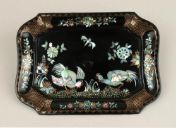Design: Cross-cultural Dialogue
Inside of the box is a tray. It is on display here so we can tell you something about it: the pearly chickens, the butterfly, and the flowers are not as distinctively ‘European’ as the buildings on the lid. Instead, the geometric borders in copper clearly make reference to the East Asian lacquerware tradition (for instance, see the borders in fig. 20 and this Japanese sword case with a checkered pattern fig. 21). On the other hand, the tray’s silhouette makes this box a typical example of Rococo design. If we virtually place this tray inside its box, which is itself decorated with buildings in European style, pyramids, and ruins, we clearly see that Heinrici designed this box with a whole world of luxury objects in mind.
The European-made commodities seeking to replicate the aesthetic and material feelings of Chinese material culture, such as this box, have been referred to as Chinoiserie pieces. This decorative style emerged in France in the late 17th century, but as this box suggests, was by the 1750s already widely spread throughout Europe. One of the reasons European-made lacquerware possibly became more desirable than their Asian ‘originals’ may be found in the fact that shapes and designs could be adapted to contemporary European fashion and taste more directly. Indeed, it seems that lacquered products from Asia were mainly loved for their luxurious materials, some of which were included in the European versions.

](https://micrio.thingsthattalk.net/Yuimx/views/max/199x128.jpg)